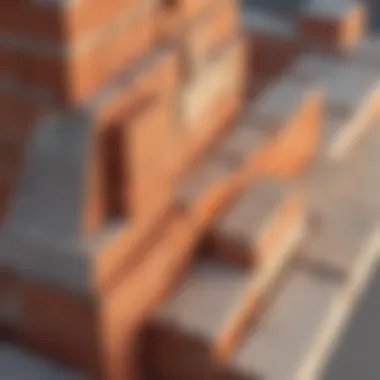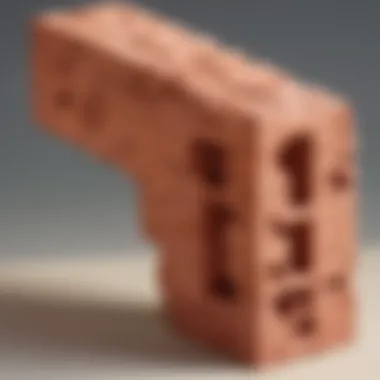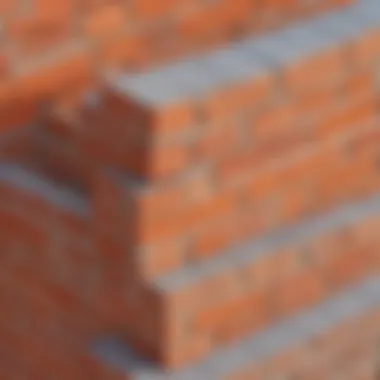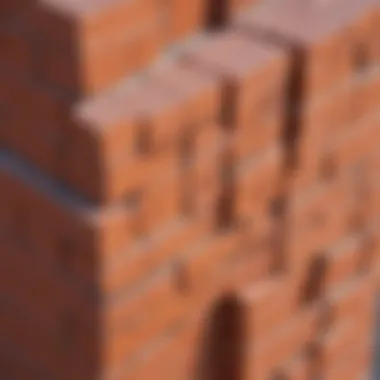Revolutionizing Construction: The Breakthrough of 3D Printed Bricks


Science Fun Facts
3D printing technology has revolutionized multiple industries, including construction, by introducing innovative methods of building structures. One remarkable advancement is the creation of 3D printed bricks, setting a new standard in construction efficiency and sustainability.
- Interesting Trivia and Facts In the realm of construction, traditional brick-making can be a labor-intensive and time-consuming process, whereas 3D printed bricks offer a more streamlined and cost-effective solution to building materials.
Discover the Wonders of Science
With the advent of 3D printing technology, the fabrication of bricks has undergone a significant transformation. By layering concrete or other suitable materials based on digital designs, 3D printers can construct bricks with precise specifications, reducing material wastage and increasing construction speed.
Science Quiz Time
Imagine a scenario where entire buildings could be constructed swiftly and with minimal human labor using 3D printed bricks. How do you think such advancements could impact the future of architecture and urban development?
Science Experiment Showcase
To showcase the capabilities of 3D printed bricks, one could conduct an experiment comparing the strength and durability of traditionally made bricks versus 3D printed bricks. By following safety protocols and utilizing the right materials, this experiment can provide valuable insights into the practical applications of this cutting-edge technology.
Introduction
Construction industry has witnessed a remarkable transformation through the advent of 3D printed bricks, a groundbreaking innovation poised to revolutionize the way structures are built. With the evolution of technology, traditional construction methods have given way to advanced techniques that promise greater efficiency, cost-effectiveness, and sustainability. This article embarks on a journey to explore the intricate world of 3D printed bricks, shedding light on how this innovation is reshaping the construction landscape.


Evolution of Construction Methods
Construction methodologies have undergone a significant evolution over the centuries, adapting to technological advancements and changing societal needs. From primitive techniques relying on manual labor to modern-day automation and robotics, the construction industry has continuously embraced innovation to enhance efficiency and precision. The evolution of construction methods is a testament to humanity's quest for improvement, seeking smarter and more sustainable ways to develop infrastructure.
While crafting intricate narratives on the progression of construction techniques, it is imperative to understand the historical context in which these methods emerged. From the ancient civilizations utilizing rudimentary tools to construct pyramids and architectural marvels, to the industrial revolution introducing mechanized construction processes, each era has contributed to the rich tapestry of construction history. The evolution of construction methods not only reflects technological progress but also mirrors societal advancements, economic shifts, and environmental considerations.
As technology continues to accelerate at an unprecedented pace, the construction industry stands at the brink of a new era marked by innovative solutions like 3D printed bricks. These revolutionary building blocks herald a paradigm shift in construction practices, offering faster production, reduced material wastage, and enhanced design flexibility. The evolution of construction methods harmonizes with the adoption of 3D printing technology, culminating in a futuristic approach to construction that aligns with the demands of the modern world.
Understanding 3D Printing
In the realm of construction innovation, one topic takes center stage: Understanding 3D Printing. This section delves deep into the essential concepts surrounding 3D printing technology, shedding light on its profound impact on the construction industry. Understanding 3D Printing is crucial as it unveils the intricate process of creating three-dimensional objects layer by layer. By grasping this fundamental aspect, readers can appreciate how 3D printed bricks revolutionize traditional construction methods. Furthermore, exploring this topic elucidates the remarkable benefits that 3D printing offers, such as increased efficiency and precision in building structures. Moreover, considerations about Understanding 3D Printing involve analyzing its scalability and adoption within the construction sector, paving the way for a new era of architectural development.
Basics of 3D Printing
The Basics of 3D Printing serve as the foundation for comprehending this groundbreaking technology. At its core, 3D printing encompasses the additive manufacturing process, where objects are created by adding material layer by layer based on a digital design. By understanding this fundamental principle, individuals can grasp the intricacies of how 3D printed bricks are meticulously crafted. Exploring the Basics of 3D Printing unveils the various techniques and technologies employed, such as Fused Deposition Modeling (FDM) or Stereolithography (SLA), which play a vital role in producing durable and precise construction elements. Additionally, delving into this aspect sheds light on the versatility of 3D printing in creating customized and complex architectural components, revolutionizing conventional construction practices.
Applications in Various Industries
The Applications of 3D Printing extend beyond the realm of construction, permeating various industries with its transformative capabilities. From healthcare to automotive, 3D printing has revolutionized manufacturing processes across different sectors. In the construction industry, the adoption of 3D printed bricks presents numerous advantages, including rapid construction, cost-effectiveness, and design flexibility. Understanding the diverse applications of this technology underscores its versatility and potential to revolutionize traditional building methods. By exploring the Applications of 3D Printing, readers can gain insight into how this innovative technology is reshaping industries and driving unprecedented advancements in manufacturing and construction.
Current Limitations


Despite its revolutionary potential, 3D printing technology also faces certain limitations that warrant consideration. Current Limitations in 3D printing technology include constraints related to material strength, scalability of production, and regulatory frameworks. Addressing these challenges is essential to unlocking the full potential of 3D printed bricks in mainstream construction practices. By examining the Current Limitations of 3D printing, industry stakeholders can identify areas for improvement and innovation, driving the evolution of this technology towards more efficient and sustainable construction methods.
Innovation in Construction: 3D Printed Bricks
Innovation in Construction: 3D Printed Bricks heralds a groundbreaking shift in the way we approach traditional construction methods. The incorporation of cutting-edge 3D printing technology revolutionizes the industry, offering a plethora of advantages that were previously unimaginable. This section delves deep into the specific elements that make 3D printed bricks a game-changer. By examining its benefits and addressing key considerations, readers will grasp the immense potential that this innovative approach brings to the table.
Overview of 3D Printed Bricks
Providing an in-depth look at 3D printed bricks, this subsection elucidates the structural marvels created through additive manufacturing. Detailing the intricacies of how each brick is meticulously crafted layer by layer, the overview highlights the precision and customization options that this technology offers. Readers will gain insight into the architectural possibilities unlocked by utilizing 3D printed bricks, setting a new standard for construction excellence.
Materials Used
The selection of materials in 3D printed brick production is pivotal to achieving durability, efficiency, and sustainability. This subsection dissects the composition of materials utilized in the process, shedding light on the innovative combinations that bolster structural integrity. From specialized concrete blends to eco-friendly additives, each component plays a crucial role in ensuring that 3D printed bricks meet the highest industry standards.
Advantages of 3D Printed Bricks
The advantages of incorporating 3D printed bricks extend far beyond mere convenience. This section expounds on the exceptional benefits that this technology brings to the construction realm. From accelerated construction timelines to reduced material wastage, 3D printed bricks showcase superior cost-effectiveness and environmental sustainability. By exploring these advantages in detail, readers will appreciate the transformative impact of embracing 3D printing in brick manufacturing.
Challenges and Considerations
While the potential of 3D printed bricks is immense, it is essential to acknowledge the challenges and considerations associated with this innovative approach. This subsection navigates through the complexities of scaling production, ensuring structural safety, and addressing regulatory standards in the realm of 3D printed brick construction. By delving into these challenges, readers will develop a nuanced understanding of the multifaceted landscape of integrating 3D printed bricks into mainstream construction practices.


Impact on Sustainability and Efficiency
The topic of Impact on Sustainability and Efficiency within the context of revolutionizing construction through 3D printed bricks is pivotal in understanding the broader implications of this innovative technology. Sustainability and efficiency are at the forefront of modern-day construction practices, with a growing emphasis on eco-conscious methods and resource optimization. By integrating 3D printed bricks into construction processes, the industry stands to benefit from reduced waste, energy efficiency, and overall environmental sustainability. These aspects play a crucial role in shaping the future landscape of construction, aligning with global efforts towards sustainability and green building practices.
When delving into the specific elements of Sustainability and Efficiency in the realm of 3D printed bricks, it is essential to highlight the reduction in material wastage compared to traditional brick manufacturing methods. Through precise layering of materials in the 3D printing process, there is a significant decrease in leftover materials, leading to a more sustainable construction approach. Furthermore, the efficiency of 3D printing technology allows for faster construction timelines, minimizing energy consumption and increasing overall project efficiency. This combination of sustainability and efficiency not only benefits the environment but also contributes to cost savings and streamlining of construction processes.
Environmental Benefits
The Environmental Benefits of utilizing 3D printed bricks extend beyond traditional construction practices, offering a host of advantages that support eco-friendly building initiatives. One of the primary environmental benefits lies in the reduction of carbon emissions associated with brick production. The use of 3D printing technology leads to a more streamlined manufacturing process, resulting in lower carbon footprints and a decreased impact on the environment.
Additionally, 3D printed bricks promote the use of recycled and sustainable materials, further enhancing their eco-friendly profile. By utilizing recycled aggregates and environmentally friendly binders, the production of these bricks contributes to the circular economy model by reducing the demand for new raw materials while diverting waste from landfills. This approach not only reduces environmental harm but also fosters a more sustainable and responsible construction industry. The environmental benefits of 3D printed bricks align with global initiatives towards combating climate change and promoting a greener built environment.
Future Prospects and Implications
In the realm of construction innovation, the future prospects and implications hold a pivotal role in shaping the trajectory of the industry. Regarding the innovation of 3D printed bricks, the future is teeming with possibilities that can revolutionize the way we perceive and construct buildings. One of the key aspects to consider is the potential scalability of this technology. As advancements continue to enhance the efficiency and effectiveness of 3D printing, integrating it into mainstream construction practices becomes increasingly feasible. This shift towards scalability can lead to a significant reduction in construction time and costs, fostering a more sustainable and economically viable approach to building.
Moreover, the implications of integrating 3D printed bricks into mainstream construction extend beyond mere efficiency gains. This technology has the potential to significantly reduce waste generated during construction, thereby promoting a more eco-friendly approach to building. By incorporating sustainable practices at the core of construction processes, we pave the way for a greener and more environmentally conscious future. Additionally, the use of 3D printed bricks opens up new design possibilities, allowing architects and designers to explore innovative structural forms and creative solutions.
As we delve deeper into the future prospects and implications of 3D printed bricks in construction, it becomes evident that this technology has the power to transform the way we approach building projects. By embracing sustainability, efficiency, and creative potential, we set the stage for a new era of construction that prioritizes innovation and environmental responsibility.
Conclusion
In the grand scheme of architecture and construction, the Conclusion serves as the capstone that solidifies the relevance and impact of 3D printed bricks in the industry. Delving into the sphere of innovative construction methods, where traditional practices intersect with cutting-edge technologies like 3D printing, the Conclusion becomes a pivotal point of reflection and projection. Through a thorough exploration of the benefits, challenges, and future prospects articulated in this article, readers are guided towards a nuanced understanding of the potentials and pitfalls inherent in adopting 3D printed bricks in construction projects. The significance of robustly crafting a Conclusion lies in its ability to draw out the overarching themes and implications for the construction sector, thereby acting as a compass for future endeavors and innovations in the field. Encompassing key elements and considerations, such as sustainability, efficiency, and architectural adaptability, the Conclusion encapsulates the transformative essence of 3D printed bricks and underscores their potential to revolutionize the construction landscape.
Summary of Key Takeaways
Providing a condensed yet insightful overview of the multifaceted landscape surrounding 3D printed bricks, the key takeaways encapsulate the essence of this revolutionary technology. One of the primary highlights is the process intricacies involved in utilizing 3D printed bricks for construction applications, shedding light on how traditional brick-making processes are evolving to meet modern demands for efficiency and sustainability. The benefits that emanate from leveraging 3D printed bricks, including enhanced design flexibility, reduced material wastage, and accelerated construction timelines, constitute compelling factors driving the industry towards embracing this innovative approach. However, it is paramount to acknowledge the existing challenges and considerations inherent in the adoption of 3D printed bricks, ranging from material properties and structural integrity to regulatory frameworks and cost implications. By synthesizing these key takeaways, readers are equipped with a comprehensive understanding of the revolutionizing potential that 3D printed bricks hold in reshaping the foundations of construction and architecture, propelling the industry towards a future characterized by efficiency, sustainability, and design ingenuity.







